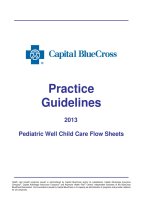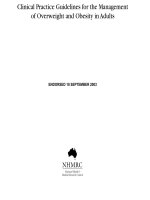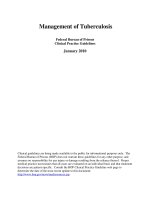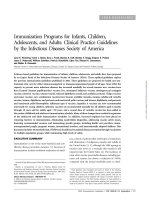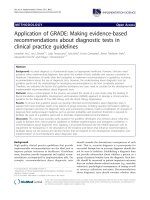Clinical cardiology, current practice guidelines demosthenes g katritsis
Bạn đang xem bản rút gọn của tài liệu. Xem và tải ngay bản đầy đủ của tài liệu tại đây (8.8 MB, 768 trang )
Clinical Cardiology
This page intentionally left blank
Clinical Cardiology
Current Practice Guidelines
Demosthenes G. Katritsis, MD, PhD, FRCP, FACC
Athens Euroclinic, Athens, Greece
Bernard J. Gersh, MB, ChB, DPhil, FRCP, FACC
Mayo Medical School, Rochester, MN, USA
A. John Camm, MD, FRCP, FACC
St George’s University of London, UK
1
3
Great Clarendon Street, Oxford, OX2 6DP,
United Kingdom
Oxford University Press is a department of the University of Oxford.
It furthers the University’s objective of excellence in research, scholarship,
and education by publishing worldwide. Oxford is a registered trade mark of
Oxford University Press in the UK and in certain other countries
© Oxford University Press 2013
The moral rights of the authors have been asserted
First Edition published in 2013
Impression: 1
All rights reserved. No part of this publication may be reproduced, stored in
a retrieval system, or transmitted, in any form or by any means, without the
prior permission in writing of Oxford University Press, or as expressly permitted
by law, by licence or under terms agreed with the appropriate reprographics
rights organization. Enquiries concerning reproduction outside the scope of the
above should be sent to the Rights Department, Oxford University Press, at the
address above
You must not circulate this work in any other form
and you must impose this same condition on any acquirer
Published in the United States of America by Oxford University Press
198 Madison Avenue, New York, NY 10016, United States of America
British Library Cataloguing in Publication Data
Data available
Library of Congress Control Number: 2013944647
ISBN 978–0–19–968528–8
Printed in Italy by
L.E.G.O. S.P.A Lavis TN
Oxford University press makes no representation, express or implied, that the
drug dosages in this book are correct. Readers must therefore always check
the product information and clinical procedures with the most up-to-date
published product information and data sheets provided by the manufacturers
and the most recent codes of conduct and safety regulations. The authors and
the publishers do not accept responsibility or legal liability for any errors in the
text or for the misuse or misapplication of material in this work. Except where
otherwise stated, drug dosages and recommendations are for the non-pregnant
adult who is not breast-feeding
Foreword
Over the years I have had the pleasure of writing forewords for a number of books that I considered to be timely and to
fulfill important objectives. Without hesitation, I would say that Clinical Cardiology: Current Practice Guidelines, by D.G.
Katritsis, B.J. Gersh, and A.J. Camm, is the most outstanding book for which I have had the pleasure to write a foreword.
Further, this is probably the book that better serves the cardiovascular specialist in day-to-day practice than any other
written in the last two decades. This is not just a textbook; it is an extraordinary “toolkit” in the context of an evidencebased cardiovascular practice in the midst of rapidly evolving scientific knowledge and guidelines.
Because of the need to integrate current knowledge on evidence-based cardiology, about three years ago, under the
auspices of the American Heart Association, we published a book that included the most recent guidelines by both the
ACCF/AHA and the ESC. I believe that such integration was a step forward for the practicing cardiologist; indeed, in a
“synopsis” fashion, this aspect is well served in Clinical Cardiology: Current Practice Guidelines. However, in the excellent compendium of my colleagues, three new components are incorporated, which we can describe as the “jewel” of the
book: a very succinct definition, classification, pathophysiology, diagnosis, management, and need of specific clinical investigation (including genetics and molecular biology) of the various disease entities; a regularly updated online version
on the most recent developments; and, most importantly a “user friendly, at a glance” presentation. These additional three
components, that make Clinical Cardiology: Current Practice Guidelines so unique, deserve a brief description.
1) In regard to the various disease entities, general textbooks tend to employ, from definition to management, a
rather long and descriptive format. In contrast, Clinical Cardiology: Current Practice Guidelines consolidates many
of the topics, regardless of their complexity, from definition to management, in a clear, concise and instructive way,
intermixed with the most recent guidelines. Thus, over 600 easily accessible tables dissect and summarize the key
points of all the latest ACCF/AHA and ESC guidelines.
2) Rapidly evolving scientific knowledge, including the value of new diagnostic and management approaches and
their incorporation in practicing guidelines, makes it difficult for the cardiovascular specialist to be aware of the
latest clinical evidence-base. Written by three leading authorities in the field, its biannually updated online version
provides the solution.
3) A novelty of this book is the “user-friendly, at glance” way of presentation that it makes it very useful to the practicing cardiovascular specialist. Useful because of its combination of succinctness and clarity, the book is up to date
in every aspect of the cardiovascular science, and particularly on the most recent recommendations from both
sides of the Atlantic. Thus, these recommendations are summarized in tables derived from the guideline documents and incorporated in the appropriate diagnostic or management sections of the 85 comprehensive chapters.
For example, when confronted with complicated clinical issues that appear in everyday clinical practice (such as
modern antiplatelet therapy of ACS, differential diagnosis of wide complex tachycardia, or management of stable
CAD in view of COURAGE, FREEDOM or STICH) physicians consult general textbooks or, often several journal
articles, in order to obtain this information in a rather loose form. In contrast, Clinical Cardiology: Current Practice
Guidelines consolidates such topics in a summarized, succinct, and clear way.
This book is a tribute to the skill of the three editors who also served as the only authors. This limited, but unified and
hardworking internationally known authorship is, without doubt, a great part of the success. It is with great pleasure that
I pen these words to relate my enthusiasm for their work as a remarkable addition to the cardiovascular field.
Valentin Fuster
Physician-in-Chief, Mount Sinai Medical Center
Director, Mount Sinai Heart
ΠΑΝΤΕΣ ΑΝΘΡΩΠΟΙ ΤΟΥ ΕΙΔΕΝΑΙ ΟΡΕΓΟΝΤΑΙ ΦΥΣΕΙ
All humans by nature desire to know
Aristotle
The Metaphysics
Prologue
The entire field of cardiovascular medicine has witnessed an era of rapid scientific progress, accompanied by continuous technological and applied innovation. This occurs against a backdrop of increasing emphasis on the importance of
evidence-based practice, and rapid development of guidelines by major professional societies. The resultant expansion of
our body of knowledge by evidence-based recommendations interjects a new set of challenges for the practicing clinician
with ever-extensive clinical responsibilities.
In order to practice evidence-based medicine, information must be easily accessible and, more importantly, easily
retrievable when the need arises; this may not always be easy with the current pace of dissemination of knowledge. The
rationale for writing this book reflects exactly this need, both ours and that of our potential readers: to organize our
continually evolving knowledge on often diverse cardiology issues, in our environment of networked and facilitated communication. In other words, to provide a clinical tool that can be used in everyday clinical practice as a concise guide to
what we know and, more importantly, what we do not know, and what we think we know. To quote Mark Twain, “what
gets us into trouble is not what we don’t know, it is what we know for sure that just ain’t so.”
The prerequisites of informed clinical practice are: a satisfactory background of basic knowledge of disease entities,
remaining up-to-date on important clinical trials and emerging scientific evidence that shape current diagnosis and
therapy, and acquaintance with current practice guidelines from established professional societies such as the American
College of Cardiology Foundation/American Heart Association (ACCF/AHA) and the European Society of Cardiology
(ESC), among many others.
Each chapter of this book has therefore been structured around the following parts:
1. A clear definition and modern classification of disease entities, followed by updated, focused information on
recent developments on the epidemiology and pathophysiology of each condition. Recent original articles and
reviews from leading journals were consulted and a summary of the most relevant information is included. Special
care was taken not to omit the most recent information on medical genetics, an expanding and promising aspect.
2. A description of the clinical presentation of the disease, with instructions on necessary clinical investigations.
Clinical investigations are presented in the context of recent evidence that dictates their current value or obsolescence. An effort has been made to include the very latest published knowledge on the clinical value of existing and
evolving tests, based on recent randomized clinical trials and guidelines by both ACCF/AHA and ESC.
3. Recommendations on management as derived from the most recent evidence available to the authors. Because
of the comprehensive nature of guidelines offered by learned societies, it was decided to provide the most recent
recommendations in a summarized, tabulated format. These are not readily accessible since overlapping guidelines
may appear on the same condition from different working groups, and updated documents are continually appearing. Thus, all guideline documents and their updates published in the US and Europe were scrutinized and classified according to year of publication. The most recent recommendations were defined, extracted and tabulated. The
resulting tables provided in the book offer the most recent recommendations on each disease entity by both ACCF/
AHA and ESC. Where appropriate, new evidence that questions the validity of specific recommendations, as well
as the opinions of established experts, and other data, such as FDA alerts are included.
4. Practical advice on “what and why to do”. Therapies, drug doses and selection of procedures are presented in a
clear and user-friendly way.
5. Carefully chosen references. Major randomized clinical trials and seminal scientific studies that define evidencebased practice are included for further reference. In addition, recent, scholarly reviews are provided, which together with the contents of the book should allow in-depth study of specific entities that may interest the individual
reader.
6. Presentation of all recent guidelines. Guidelines are referenced and presented separately in order to guide the
reader to the most recent publications by ACCF/AHA and ESC.
An inherent disadvantage of a medical textbook is inability to keep up-to-date with recent developments. To overcome
the problem, the online version of this book will be updated, initially on a 6-monthly basis.
This book would have never been possible without the wholehearted support and commitment of Helen Liepman, our
Senior Editor at Oxford University Press. We are grateful for her acceptance of our view of a “next generation textbook”.
We also thank Imogen Lowe, Mark Knowles, and Richard Martin of Oxford University Press. Their professionalism and
assistance throughout the production process is much appreciated.
Demosthenes G. Katritsis
Bernard J. Gersh
A. John Camm
Contents
List of abbreviations
xxv
Part 1 Grown-up congenital heart disease
1 Grown-up congenital heart disease: general principles
Definition 3
Epidemiology 3
Aetiology 3
Clinical problems in GUCH 3
Imaging techniques and investigations 4
Principles of management 5
2 Ventricular septal defects
9
Definition and classification 9
Epidemiology 9
Aetiology 9
Pathophysiology 9
Presentation 10
Physical examination 10
Investigations 10
Therapy 10
Pregnancy 11
3 Atrioventricular septal defects
12
Definitions and classification of AVSDs
Ostium primum ASD 12
4 Atrial septal defects
15
Ostium secundum ASD 15
Sinus venosus defect 17
Patent foramen ovale 17
5 Patent ductus arteriosus
19
Definition 19
Epidemiology 19
Aetiology 19
Pathophysiology and natural history 20
Presentation 20
Physical examination 20
Investigations 20
Therapy 20
12
3
x
CONTENTS
6 Right ventricular outflow tract obstruction
22
Definitions and classification of RVOT obstruction 22
Valvular pulmonary stenosis 22
Subvalvular pulmonary stenosis 22
Supravalvar pulmonary stenosis 23
Branch pulmonary artery stenosis 23
7 Left ventricular outflow tract obstruction
25
Definitions and classification of LVOT obstruction 25
Valvular aortic stenosis (bicuspid aortic valve) 25
Subvalvular aortic stenosis 27
Supravalvular aortic stenosis 28
8 Coarctation of the aorta
29
Definitions 29
Epidemiology 29
Pathophysiology and natural history 29
Presentation 30
Physical examination 30
Investigations 30
Therapy 30
Pregnancy 31
9 Tetralogy of Fallot
31
Definition 31
Epidemiology 31
Aetiology 32
Pathophysiology 32
Presentation 32
Physical examination 32
Investigations 32
Therapy 32
Indications for intervention after repair
Participation in exercise 33
Pregnancy 33
33
10 Transposition of great arteries
34
Definitions and classification of TGA 34
Complete TGA (d-TGA) 35
Congenitally corrected transposition (l-TGA)
11 Ebstein’s anomaly
40
Definition 40
Epidemiology 40
Presentation 40
Physical examination
41
38
CONTENTS
Investigations 41
Therapy 41
Pregnancy 42
12 Anomalous PV connections, AV malformations, coronary
and LV abnormalities 43
Total anomalous pulmonary venous connection (TAPVC) 43
Partial anomalous pulmonary venous connection (PAPVC) 43
Pulmonary arteriovenous malformations 43
Congenital coronary anomalies 43
Coronary fistulas 43
Left ventricular protrusions 44
13 The Fontan patient
45
Definition 45
Pathophysiology 45
Clinical problems 45
Therapy 45
14 Eisenmenger syndrome
47
Definition 47
Pathophysiology 47
Clinical problems 48
Physical examination 48
Investigations 49
Therapy 49
Part 2 Valve disease
15 General principles
53
Epidemiology 53
Cardiac auscultation 53
Coronary angiography 54
Endocarditis prophylaxis 54
Pregnancy 54
16 Mitral stenosis
56
Epidemiology 56
Aetiology 56
Pathophysiology and natural history 56
Presentation 57
Physical examination 57
Investigations 57
Therapy 57
Non-cardiac surgery 63
Pregnancy 64
xi
xii
CONTENTS
17 Mitral regurgitation
66
Classification 66
Epidemiology 66
Aetiology 66
Pathophysiology and natural history 66
Presentation 67
Physical examination 67
Investigations 67
Therapy 68
Non-cardiac surgery 74
Pregnancy 74
18 Aortic stenosis
75
Epidemiology 75
Aetiology 76
Pathophysiology and natural history 76
Presentation 76
Physical examination 76
Investigations 77
Therapy 79
Non-cardiac surgery 85
Pregnancy 86
19 Aortic regurgitation
88
Epidemiology 88
Aetiology 88
Pathophysiology and natural history 88
Presentation 89
Physical examination 89
Investigations 89
Therapy 90
Non-cardiac surgery 92
Pregnancy 94
20 Tricuspid valve disease
94
Tricuspid regurgitation 94
Tricuspid stenosis 97
21 Pulmonary valve disease
98
Pulmonary valve regurgitation 98
Pulmonary valve stenosis 98
22 Prosthetic heart valves
99
Risk stratification for surgery 99
Mechanical valves 99
Tissue valves (bioprostheses) 99
CONTENTS
Anticoagulation 100
MRI 102
Thrombosis of prosthetic valves 102
Haemolysis 103
Paravalvular leaks 103
Pregnancy 103
Part 3 Systemic hypertension
23 Classification and pathophysiology of hypertension
111
Definition 111
Epidemiology 111
Pathophysiology 111
Subtypes of hypertension 113
Blood pressure measurement 114
24 Primary (essential) hypertension
117
Risk stratification 117
Physical examination 117
Investigations 119
Therapy 119
Resistant hypertension 131
Hypertensive crisis 132
Hypertension in pregnancy 133
25 Secondary hypertension
137
Introduction 137
Renal parenchymal disease 137
Renovascular hypertension 137
Primary aldosteronism 138
Phaeochromocytoma 140
Adrenal ‘incidentaloma’ 140
Other causes of hypertension 140
Part 4 Coronary artery disease
26 Epidemiology and pathophysiology of coronary artery disease
145
Definitions and classification 145
Epidemiology 145
Aetiology 145
Pathophysiology 146
27 Unstable angina and non-ST elevation myocardial infarction
Definition 149
Presentation 150
149
xiii
xiv
CONTENTS
Diagnosis 150
Therapy 150
Invasive vs conservative management 166
Specific patient groups 168
Complications 170
Risk stratification before discharge 173
Post-hospital discharge care 173
28 Acute myocardial infarction
177
Definition 177
Presentation 177
Physical examination 177
Diagnosis 178
Initial therapy and medication 182
Reperfusion therapy 187
Complications of MI 196
Discharge 204
Chronic therapy 204
Stem cell transplantation 208
29 Stable coronary artery disease
212
Definition 212
Presentation 212
Physical examination 212
Investigations 212
Differential diagnosis 221
Risk stratification 222
Therapy 223
Evaluation and risk assessment before non-cardiac surgery 251
Part 5 Heart failure
30 Classification, epidemiology, and pathophysiology of heart failure
Definitions and classification 267
Epidemiology 267
Pathophysiology 267
Aetiology 268
31 Chronic heart failure
Presentation 270
Physical examination
Investigations 272
Prognosis 278
Therapy 278
Pregnancy 302
270
270
267
CONTENTS
32 Heart failure with preserved LVEF
306
Definition 306
Aetiology and pathophysiology 306
Epidemiology 306
Clinical presentation 306
Diagnosis 307
Therapy 307
33 Acute heart failure and cardiogenic shock
Acute heart failure 308
Cardiogenic shock 314
Part 6 Cardiomyopathies
34 Classification of cardiomyopathies
319
Introduction 319
American Heart Association (2006) 319
European Society of Cardiology (2008) 319
35 Dilated cardiomyopathy
324
Definition 324
Epidemiology 324
Aetiology and pathophysiology 324
Presentation 327
Physical examination 327
Investigations 327
Risk stratification 327
Therapy 328
Prognosis 329
Pregnancy 329
36 Hypertrophic cardiomyopathy
331
Definition 331
Epidemiology 331
Aetiology 331
Pathophysiology 331
Presentation and natural history 333
Physical examination 335
Investigations 335
Differential diagnosis 336
Therapy 336
Physical activity and sports 343
Family counselling and genetic testing 343
Pregnancy 346
308
xv
xvi
CONTENTS
37 Restrictive cardiomyopathy
348
Definition 348
Pathophysiology 348
Aetiology 348
Presentation 349
Physical examination 350
Investigations 350
Differential diagnosis 351
Therapy 352
38 Arrhythmogenic right ventricular cardiomyopathy/dysplasia
Definition 353
Epidemiology 353
Aetiology 353
Pathophysiology 354
Presentation 355
Investigations 355
Differential diagnosis 357
Risk stratification 357
Therapy 357
Genetic testing 359
Pregnancy 360
39 Peripartum cardiomyopathy
Definition 361
Epidemiology 361
Aetiology 362
Presentation 362
Investigations 362
Therapy 362
Delivery 363
Prognosis 363
40 Tachycardiomyopathy
364
Definition 364
Epidemiology 364
Aetiology 364
Pathophysiology 364
Presentation 364
Diagnosis 364
Therapy 364
41 Stress cardiomyopathy
Definition 365
Pathophysiology 365
365
361
353
CONTENTS
Diagnosis 365
Therapy 365
42 Iron overload cardiomyopathies
367
Definition 367
Aetiology 367
Pathophysiology 367
Presentation 367
Diagnosis 367
Therapy 367
43 Left ventricular non-compaction
369
Definition 369
Epidemiology 369
Aetiology 369
Presentation 369
Diagnosis 369
Therapy 370
Part 7 Myocarditis
44 Acute myocarditis
373
Definition and classification 373
Epidemiology 373
Aetiology 373
Pathophysiology 373
Presentation 373
Physical examination 374
Investigations 374
Therapy 374
Prognosis 375
Part 8 Pericardial disease
45 Pericardial anatomy and congenital pericardial defects
Pericardial anatomy 379
Congenital pericardial defects
379
46 Acute and relapsing pericarditis
379
Acute pericarditis 379
Relapsing pericarditis 382
47 Pericardial effusion and cardiac tamponade
Pericardial effusion 383
Cardiac tamponade 385
383
379
xvii
xviii
CONTENTS
48 Constrictive pericarditis
388
Definition 388
Aetiology 388
Pathophysiology 388
Presentation 388
Physical examination 388
Investigations 388
Differential diagnosis 390
Therapy 390
Part 9 Tachyarrhythmias
49 Classification of tachyarrhythmias, mechanisms of arrhythmogenesis,
and acute management 393
Definitions and classification 393
Electrophysiological mechanisms of arrhythmogenesis 393
Acute management of tachyarrhythmias 399
50 Classification, epidemiology, and presentation of supraventricular tachycardias
Definitions and classification 403
Epidemiology of SVT 403
Presentation of SVT 403
SVT in congenital heart disease 403
SVT in pregnancy 405
Therapy of SVT 405
51 Atrial tachycardias
406
Atrial and junctional premature beats 406
Physiological sinus tachycardia 407
Inappropriate sinus tachycardia 407
Sinus reentrant tachycardia 408
Focal atrial tachycardia 408
Multifocal atrial tachycardia 409
Macro-reentrant atrial tachycardias (atrial flutters)
52 Atrial fibrillation
413
Definitions and classification 413
Epidemiology 413
Aetiology 414
Pathophysiology 414
Diagnosis 415
Investigations 416
Risk stratification 417
Therapy 417
410
403
CONTENTS
AF in specific conditions
AF in pregnancy 447
444
53 Atrioventricular junctional tachycardias
456
Atrioventricular nodal reentrant tachycardia 456
Non-reentrant junctional tachycardias 462
54 Atrioventricular reentrant tachycardias
464
Definitions 464
Epidemiology 464
Pathophysiology 464
Aetiology 465
Presentation 465
Diagnosis 465
Risk stratification in WPW syndrome 467
Therapy 467
55 Ventricular arrhythmias
470
Definitions and classification 470
Pathophysiology 470
Presentation 473
Differential diagnosis of wide QRS tachycardia 473
Acute therapy of ventricular arrhythmias 474
Risk stratification 477
Long-term therapy 483
Clinical forms of ventricular arrhythmias 484
Part 10 Genetic channelopathies
56 Definitions of inherited arrhythmias
Definitions 507
Glossary of terms and acronyms 507
57 Long QT syndrome
512
Definition 512
Epidemiology 512
Pathophysiology and genetics 512
Presentation 513
Diagnosis 513
Genetic testing 515
Specific LQTS types 515
Therapy 516
58 Short QT syndrome
Definition 518
Aetiology 518
518
507
xix
xx
CONTENTS
Presentation 518
Diagnosis 518
Therapy 519
59 Brugada syndrome
521
Definition 521
Epidemiology 521
Genetics and pathophysiology 521
Presentation 522
Diagnosis 522
Risk stratification 524
Therapy 524
60 Catecholaminergic polymorphic ventricular tachycardia
Definition 528
Epidemiology 528
Genetics and pathophysiology 528
Presentation 528
Diagnosis 528
Therapy 528
61 Early repolarization syndromes
530
Definition 530
Genetics and pathophysiology 530
Clinical significance 531
Therapy 533
Part 11 Bradyarrhythmias
62 The cardiac conduction system
537
Overview 537
63 Sinus nodal disease
539
Sinus bradycardia 539
Sick sinus syndrome 539
64 Atrioventricular and intraventricular block
Atrioventricular block 543
Atrioventricular dissociation
Intraventricular block 548
543
548
65 Conduction disease in specific conditions
Recent myocardial infarction 553
Congenital AV block 553
Sleep apnoea 554
Cardiac transplantation 554
Pacing in pregnancy 554
Other pacing indications 556
553
528
CONTENTS
Part 12 Syncope and sudden cardiac death
66 Syncope
561
Definition 561
Epidemiology 561
Classification 561
Pathophysiology 561
Presentation 561
Aetiologic diagnosis 561
Investigations 562
Risk stratification 566
Therapy 568
Driving 571
67 Sudden cardiac death
573
Definition 573
Epidemiology 573
Aetiology 574
Pathophysiology 575
Investigations in survivors 575
Management of cardiac arrest 577
Part 13 Implantable devices
68 Technical issues
581
Permanent pacemakers 581
Biventricular pacing 582
Implantable cardioverter-defibrillators 582
69 Complications of implantable devices
586
Implantation-related complications 586
Device-related infections 587
Device implantation in the anticoagulated patient 587
Reimplantation 587
Perioperative management of patients with devices 590
Magnetic resonance imaging 594
Driving and sexual activity 594
Part 14 Diseases of the aorta
70 Acute aortic syndromes
599
Definitions and classification 599
Epidemiology 600
Pathophysiology 600
Aetiology 600
Presentation 600
xxi
xxii
CONTENTS
Physical findings 601
Diagnosis 601
Therapy 603
Follow-up 608
71 Thoracic aortic aneurysms and other conditions
609
Thoracic aortic aneurysms 609
Aortic arch and thoracic aortic atheroma and atheroembolic disease 612
Cardiovascular conditions associated with thoracic aortic disease 612
72 Genetic syndromes associated with thoracic aneurysm and dissection
614
Marfan’s syndrome 614
Other heritable syndromes and genetic defects associated with thoracic aortic disease 617
73 Inflammatory diseases associated with thoracic aortic disease
Introduction 618
Takayasu’s arteritis 619
Giant cell (temporal) arteritis
618
620
Part 15 Venous thromboembolism
74 Pulmonary embolism
623
Definitions 623
Epidemiology 623
Pathophysiology 623
Aetiology 623
Presentation 624
Diagnosis 624
Risk stratification 626
Acute therapy 626
Long-term therapy 630
Special conditions 631
75 Deep vein thrombosis
634
Overview 634
Thromboembolism in pregnancy
634
Part 16 Pulmonary hypertension
76 Definitions and classification of pulmonary hypertension
641
Definition and classification 641
77 Pulmonary arterial hypertension and hypertension associated with pulmonary
venous abnormalities 642
Pulmonary arterial hypertension
642
CONTENTS
Pulmonary hypertension associated with pulmonary venous capillary
abnormalities 653
78 Pulmonary hypertension associated with left heart disease and lung disease, and
chronic thromboembolic pulmonary hypertension 654
Pulmonary hypertension associated with left heart disease 654
Pulmonary hypertension associated with lung disease 655
Chronic thromboembolic pulmonary hypertension 655
Part 17 Infective endocarditis
79 Infective endocarditis
661
Definition 661
Epidemiology 661
Aetiology 661
Pathophysiology 661
Presentation 661
Clinical features 664
Diagnosis 664
Therapy 665
Complications 666
Prognosis 670
Pregnancy 670
Prophylaxis 670
Part 18 Rheumatic fever
80 Rheumatic fever
677
Definition 677
Epidemiology 677
Aetiology 677
Pathophysiology 677
Presentation 677
Clinical forms 677
Diagnosis 678
Therapy 679
Prophylaxis 679
Part 19 Athlete’s heart
81 Athlete’s heart
683
Exercise-induced cardiac remodelling 683
Interpretation of the ECG in athletes 683
xxiii
xxiv
CONTENTS
Arrhythmias in athletes 687
Classification of sports 687
Part 20 Cardiac tumours and pseudoaneurysms
82 Cardiac tumours
691
Primary cardiac tumours 691
Cardiac metastases 691
83 Pseudoaneurysms of the heart
692
Introduction 692
Aetiology 692
Diagnosis 692
Treatment 692
Part 21 Cardiovascular disease in pregnancy
84 Cardiovascular disease in pregnancy
695
Overview 695
Part 22 Cardiovascular drugs
85 Cardiovascular drugs
701
Antiarrhythmic drugs 701
Antiplatelet agents 701
Anticoagulants 701
Beta blockers, diuretics, ACEIs, ARBs, CCBs
Statins, fibrates 701
Drugs for erectile dysfunction 701
701
Appendix 1: Recommendation classes and levels of evidence
used in guidelines 703
Appendix 2: Therapy of endocarditis 705
Appendix 3: ESC 2011 on pregnancy 713
Index 717
